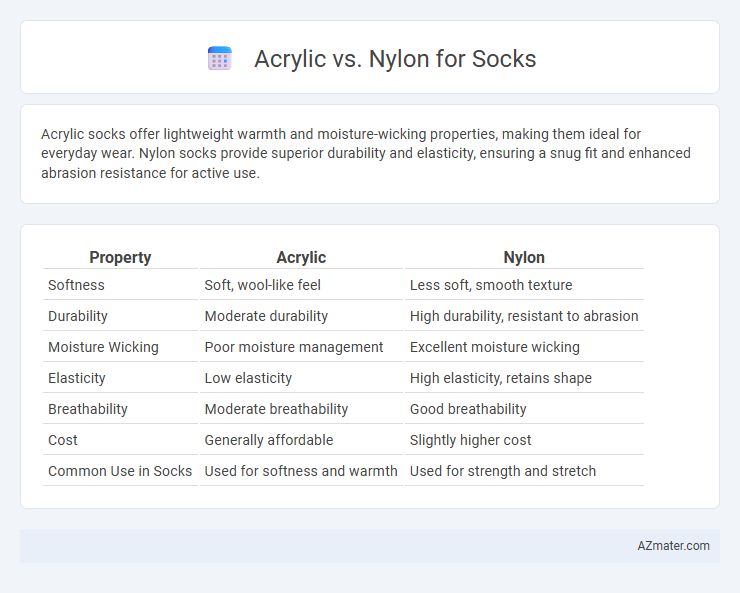Acrylic socks offer lightweight warmth and moisture-wicking properties, making them ideal for everyday wear. Nylon socks provide superior durability and elasticity, ensuring a snug fit and enhanced abrasion resistance for active use.
Table of Comparison
| Property | Acrylic | Nylon |
|---|---|---|
| Softness | Soft, wool-like feel | Less soft, smooth texture |
| Durability | Moderate durability | High durability, resistant to abrasion |
| Moisture Wicking | Poor moisture management | Excellent moisture wicking |
| Elasticity | Low elasticity | High elasticity, retains shape |
| Breathability | Moderate breathability | Good breathability |
| Cost | Generally affordable | Slightly higher cost |
| Common Use in Socks | Used for softness and warmth | Used for strength and stretch |
Introduction to Acrylic and Nylon Socks
Acrylic socks are crafted from synthetic fibers known for their softness, warmth, and moisture-wicking properties, making them ideal for cold weather and athletic use. Nylon socks offer exceptional durability, elasticity, and resistance to abrasion, providing a snug fit that maintains shape over time. Both materials contribute to comfort and performance, with acrylic excelling in insulation and nylon in strength and flexibility.
Material Composition of Acrylic vs Nylon
Acrylic socks are made from synthetic polymer fibers derived from polyacrylonitrile, offering softness and moisture-wicking properties that help keep feet dry. Nylon socks use polyamide fibers known for their exceptional strength, elasticity, and durability, enhancing sock longevity and fit retention. Combining acrylic and nylon blends in sock manufacturing often balances comfort, warmth, and abrasion resistance, optimizing performance for everyday wear.
Comfort and Feel on Skin
Acrylic socks offer a soft, wool-like feel that is lightweight and warm, making them comfortable for extended wear without causing irritation. Nylon socks provide a smooth, stretchy texture that enhances fit and durability while maintaining breathability and moisture-wicking properties. Both materials deliver comfort, but acrylic excels in warmth and softness, whereas nylon prioritizes stretch and skin-friendly performance.
Moisture-Wicking Properties
Nylon socks offer superior moisture-wicking properties compared to acrylic, efficiently drawing sweat away from the skin to keep feet dry and comfortable during intense activities. Acrylic fibers, while soft and lightweight, tend to retain moisture, making them less effective at managing sweat and potentially leading to discomfort or blisters. Choosing nylon socks enhances breathability and moisture management, crucial for athletic performance and extended wear.
Durability and Longevity
Acrylic socks offer excellent durability due to their resistance to wear, moisture, and shrinking, maintaining shape and color over long periods. Nylon socks excel in longevity by providing strong elasticity and abrasion resistance, which helps prevent holes and extends sock lifespan. Both materials contribute to durable socks, with acrylic favoring softness and moisture-wicking, while nylon emphasizes toughness and stretch retention.
Breathability and Temperature Regulation
Acrylic socks offer moderate breathability and retain heat well, making them suitable for cooler environments but less effective at moisture wicking. Nylon socks provide superior moisture management and enhanced airflow, promoting better temperature regulation and keeping feet dry during physical activity. Choosing between acrylic and nylon depends on the need for insulation versus breathability in sock performance.
Odor Control Comparison
Acrylic fibers provide moderate odor control by resisting moisture absorption, which helps reduce bacterial growth compared to natural fibers. Nylon socks offer superior odor control due to their enhanced moisture-wicking properties and quick-drying capabilities, minimizing the environment for odor-causing bacteria. Both materials improve sock hygiene, but nylon is generally preferred for prolonged odor resistance during intense physical activity.
Suitability for Athletic vs Everyday Wear
Acrylic socks offer moisture-wicking and durability, making them suitable for everyday wear where comfort and warmth are priorities. Nylon socks provide superior stretch, breathability, and strength, ideal for athletic activities requiring flexibility and moisture management. Choosing between acrylic and nylon depends on whether the primary need is casual comfort or high-performance support during physical exercise.
Care and Maintenance Requirements
Acrylic socks are machine washable and dry quickly, making them easy to care for with resistance to shrinking and fading. Nylon socks require gentle washing and should be air-dried to maintain elasticity and prevent damage. Both materials benefit from avoiding high heat and harsh detergents to prolong softness and durability.
Cost and Value Considerations
Acrylic socks generally offer a lower upfront cost compared to nylon, making them a budget-friendly option for everyday wear. Nylon socks provide enhanced durability and elasticity, often resulting in a longer lifespan despite a higher initial price. Evaluating cost per use reveals that nylon may deliver better value over time due to its resilience and retained fit after multiple washes.

Infographic: Acrylic vs Nylon for Sock
 azmater.com
azmater.com